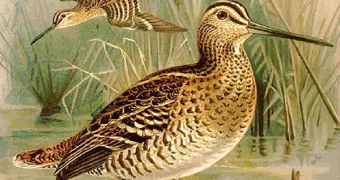With the ability to cover more than 4,000 miles in an 96-hour-long flight, the great snipe is definitely one of the most remarkable animals on Earth. The small bird, which looks rather plump, flies the fastest long-duration flight of anything except airplanes.
The shorebird can fly for 4 consecutive days without needing time to rest or feed, experts say. This means that it covers the equivalent of 1,000 miles per day. At times, the animal can reach cruise speeds of up to 50 miles (80.5 kilometers) per hour.
The great snipe is displaying its amazing capabilities during its annual migrations, say investigators who conducted a new study on the bird. Details of the work appear in the May 25 issue of the respected scientific journal Biology Letters.
“We know of no other animal that travels this rapidly over such a long distance,” the research team writes. The experts were led by Swedish biologist Raymond Klaasen, who holds an appointment at the Lund University.
Using geolocating tags, the expert and his team followed the migration of 10 such birds in May 2009. The animals were captured on the western coast of Sweden, tagged, and then released into the wild.
The following year, with great difficulty, the team managed to recapture three of the original 10 birds. After removing the tags, the experts deciphered the data, and were amazed by the flight patterns they saw within, Wired reports.
Apparently, the birds had flown nonstop from Sweden to central Africa. The trips covered 2,800, 3,800 and 4,200 miles, respectively, and lasted between 48 and 84 hours, the researchers reports.
The great snipe is not the longest-flying bird in the world. Godwits hold that title, as they are capable of flying from Alaska to New Zealand in nine days, covering 7,145 miles (11,498 km) in the process.
However, that bird is capable of an average speed of 35 miles per hour, whereas the great snipe can reach 50 miles per hour. Interestingly, the latter have the option to stop and feed, but choose not to.
Godwits have no choice but to fly non-stop, seeing how they have to cross the entire Pacific Ocean. But the snipes' flight path takes the birds over land that could easily accommodate their needs.
This “represent[s] an unexpected and previously unknown strategy in bird migration,” Klaasen’s team wrote in the journal entry.

 14 DAY TRIAL //
14 DAY TRIAL //